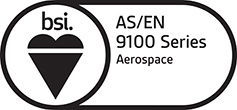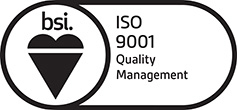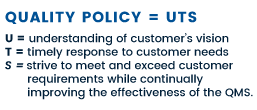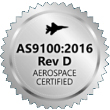We provide a structured, documented approach to supplier improvement activities.
Unitek Technical Services a Kiwa Company is a leading provider of Supply Chain Quality services for clients in the aerospace and other quality critical industries. Our technical specialists utilize a variety of proven development techniques that provide a structured, documented approach to supplier improvement activities.
Organizations with complex supply chains, supplier development programs are essential to ensuring quality product arrives on-time. Depending on the needs of your business, a supplier development program will involve a range of services.
Unitek’s Quality Engineers use a systemic and methodological process to solve problems, ensure the conformance of products to requirements, improve production process and increase the reliability of product performance. These processes include, but are not limited to: planning, control, and improvement techniques such as; statistical process control (SPC), acceptance sampling, design of experiments (DOE), regression analysis, reliability and maintainability, Taguchi Methods, quality function deployment, failure modes and effects analysis (FMEA) and total productive maintenance (TPM).Quality Engineers will often be the individuals tasked with the creation of quality practices and documentation for a given product or facility. They set out appropriate tests and acceptable result parameters to ensure that quality testing throughout the manufacturing process is effective. Even at the point of troubleshooting, quality engineering is about more than just identifying problems; it’s about understanding the underlying issues and developing successful fixes, while changing practices where necessary to ensure that standards are maintained. The role of a quality engineer can vary greatly between companies. Unitek’s Quality Engineers will work within a wider team of our customer and / or supplier quality professionals with the overall goal of maintaining the quality of the final product.
Unitek’s Quality Engineers work with various stakeholders at every part of the manufacturing process. Examples include:
- Design teams – Designing quality into the product to increase product durability and reduce areas of weakness.
- Suppliers – Working to ensure proper requirement flow-down from correct raw materials ordering, component feature verification, special processing as well as packaging and part labeling that meet the customer requirements.
- Manufacturing teams – Ensuring that equipment and processes follow proper manufacturing work instructions and defined quality standards.
- Customers – Analyzing supplier issues reported via customer feedback, maintaining records and implementing changes to manufacturing processes when necessary and approved.
Customers can utilize Unitek’s Quality Engineers to support:
- Creation of quality documentation and development of Standard Operating Procedures (SOP’s) for the requested facility and products in line with their requirements.
- Proactive review and improvement of systems and processes to ensure maintenance of standards.
- Development and maintenance of accurate quality documentation.
- Working closely with manufacturing staff to ensure quality protocols are followed and documentation is correctly maintained and implemented after any approved changes.
- Inspection and testing of various parts of the manufacturing process including: raw materials, components at Work in Process (WIP) and Final, special processes while comparing against defined requirements.
- Analyzing problems detected and developing improvements to overcome them
- Review of packaging and labeling requirements
- Statistical analysis of manufacturing data and creation of reports for senior staff members based on management reporting requirements.
- Working closely with external partners e.g. customers, suppliers and sub-tiers.
- Continuous improvement to the manufacturing process.
Successful quality engineering ensures that final products are safe and meet customer expectations while keeping the manufacturing process as effective and cost-efficient as possible.
In order to achieve a high level of final product quality, systems should be producing low variability product at every step of the manufacturing process. Rather than wait till the end of the process to discover poor quality product, monitoring in real time should be performed at critical intermediate steps during the process. When variability is discovered, the objective is to make process adjustments to avoid that variability from ever occurring again.
A Gap Analysis is an analytical methodology to identify missing details “or gaps” in a document, process or procedure when both the current and future states are identified.
The gap process can be broken into the following basic steps:
- Identify the current state of your process.
- Identify where you want to be (future) with your process.
- Identify the gaps in your process (from current to future).
- Devise improvements to close the gaps in your process.
Root Cause Analysis (RCA) is a tool to help identify what, how and why an event occurred so that steps can be taken to prevent future occurrences. RCA may be used to target opportunities for system wide improvement, and generates effective recommendations to prevent recurrences. The RCA process involves data collecting, causal factor charting, root cause identification, and recommendation generation and implementation. Only when a company is able to determine why an event or failure occurred will they be able to specify workable corrective measures that prevent future occurrences.
Several types of RCA tools include:
- 5 Why’s – Ishikawa Diagram
- The eight disciplines (8D) model
- Pareto Diagram
- Failure Mode Effects Analysis (FMEA)
- Fault Tree
Corrective Actions are a set of actions or improvements to an organization’s processes within manufacturing, documentation, procedures, or management systems to rectify and eliminate recurring causes of non-conformities.
Corrective actions are implemented in response to customer complaints, unacceptable levels of product non-conformance, issues identified during an internal audit, as well as adverse or unstable trends in product and process monitoring as identified by statistical process control (SPC) results.
Corrective Action process outline:
- Locate and document the root cause of the nonconformity.
- Review the entire process to ensure no other similar nonconformity could occur.
- Analyze the effect that the nonconformity may have had on a product or service and take action appropriate to the severity of the situation by either recalling the product, notifying the customer, containment/sorting or scrapping the product.
- Establish thorough follow-up to ensure the verification that the correction is effective and recurrence has been prevented.
Determines how to create a process that best test a particular product in manufacturing and related disciplines in order to assure that the product meets applicable specifications. Unitek can assist with the development of testing requirements for performance validation of prototype through production systems.
Troubleshooting is a form of problem solving, often applied to repair failed products or processes. Troubleshooting requires identification of the error or symptoms within a system therefore possible causes of the issue are documented. Determining the most likely cause is a process of elimination, where by one eradicates potential causes of a problem. Finally, troubleshooting requires confirmation that the solution would restore the product or process to its working state.
Error proofing is any mechanism or process changes that helps eliminate defects by preventing or drawing attention to human error as they occur. Through implementation of Error Proofing techniques to detect the error at the source, we can prevent the non-conforming part or product from being produced.
Unitek can offer a range of training services from the development of materials thru the scheduling and administering of the developed training content. The training administration can be performed one on one, group based remote/regionally, group based at an HQ location, web based or via teleconference; the customer may base their decision on timing, effectiveness/surety and budget.
Range of training topics include, but are not limited to:
- Inspection methodology and records systems processing
- Auditor Training
- Designated Supplier Quality Representative (DSQR) Authorization and Certification
Advanced Product Quality Planning (APQP)
APQP is a quality focused approach to product development through the use of phased planning process with specific deliverables monitored and tracked to close with mitigating risks as they are identified.
It’s also an upfront planning for, resources, quality product, managing cost, Identification of required changes in early stages, avoidance of late changes and on time product delivery.
APQP applies to both new product development and also changes to current product in production.
APQP also encourages cross functional teamwork.
Production Part Approval Process (PPAP)
PPAP is documented process that manufacturers and suppliers follow to communicate and obtain approval from customers prior to start of production.
PPAP process is in a production environment utilizing production tooling and equipment.
PPAP provides evidence that the manufacturing process can produce product that meets customer’s design requirements.
Elements of PPAP:
- Design Records
- Authorized Engineering Change (note) Documents
- Engineering Approval
- DFMEA
- Process Flow Diagram
- PFMEA
- Control Plan
- Measurement System Analysis Studies (MSA)
- Dimensional Results
- Records of Material / Performance Tests
- Initial Process Studies
- Qualified Laboratory Documentation
- Appearance Approval Report
- Sample Production Parts
- Master Sample
- Checking Aids
- Customer-Specific Requirements
- Part Submission Warrant (PSW)
To learn more about our supplier development and improvement services, please contact us today.




